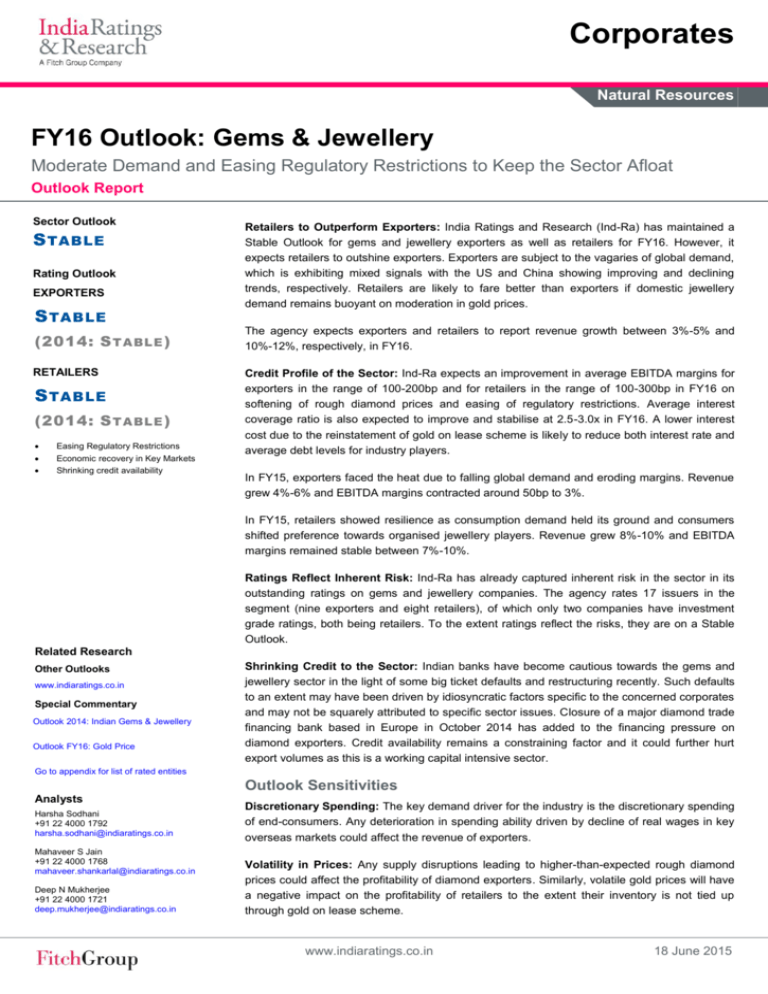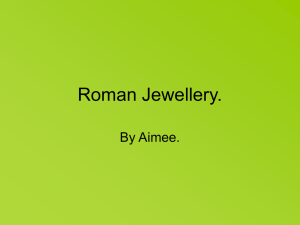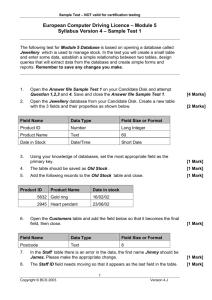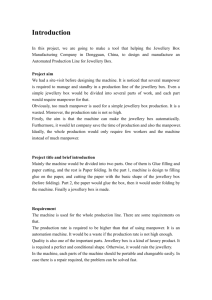
Corporates
Natural Resources
FY16 Outlook: Gems & Jewellery
Moderate Demand and Easing Regulatory Restrictions to Keep the Sector Afloat
Outlook Report
Sector Outlook
S TABLE
Rating Outlook
EXPORTERS
S TABLE
Retailers to Outperform Exporters: India Ratings and Research (Ind-Ra) has maintained a
Stable Outlook for gems and jewellery exporters as well as retailers for FY16. However, it
expects retailers to outshine exporters. Exporters are subject to the vagaries of global demand,
which is exhibiting mixed signals with the US and China showing improving and declining
trends, respectively. Retailers are likely to fare better than exporters if domestic jewellery
demand remains buoyant on moderation in gold prices.
(2014: S T A BL E )
The agency expects exporters and retailers to report revenue growth between 3%-5% and
10%-12%, respectively, in FY16.
RETAILERS
Credit Profile of the Sector: Ind-Ra expects an improvement in average EBITDA margins for
exporters in the range of 100-200bp and for retailers in the range of 100-300bp in FY16 on
softening of rough diamond prices and easing of regulatory restrictions. Average interest
coverage ratio is also expected to improve and stabilise at 2.5-3.0x in FY16. A lower interest
cost due to the reinstatement of gold on lease scheme is likely to reduce both interest rate and
average debt levels for industry players.
S TABLE
(2014: S T A BL E )
Easing Regulatory Restrictions
Economic recovery in Key Markets
Shrinking credit availability
In FY15, exporters faced the heat due to falling global demand and eroding margins. Revenue
grew 4%-6% and EBITDA margins contracted around 50bp to 3%.
In FY15, retailers showed resilience as consumption demand held its ground and consumers
shifted preference towards organised jewellery players. Revenue grew 8%-10% and EBITDA
margins remained stable between 7%-10%.
Ratings Reflect Inherent Risk: Ind-Ra has already captured inherent risk in the sector in its
outstanding ratings on gems and jewellery companies. The agency rates 17 issuers in the
segment (nine exporters and eight retailers), of which only two companies have investment
grade ratings, both being retailers. To the extent ratings reflect the risks, they are on a Stable
Outlook.
Related Research
Other Outlooks
www.indiaratings.co.in
Special Commentary
Outlook 2014: Indian Gems & Jewellery
Outlook FY16: Gold Price
Shrinking Credit to the Sector: Indian banks have become cautious towards the gems and
jewellery sector in the light of some big ticket defaults and restructuring recently. Such defaults
to an extent may have been driven by idiosyncratic factors specific to the concerned corporates
and may not be squarely attributed to specific sector issues. Closure of a major diamond trade
financing bank based in Europe in October 2014 has added to the financing pressure on
diamond exporters. Credit availability remains a constraining factor and it could further hurt
export volumes as this is a working capital intensive sector.
Go to appendix for list of rated entities
Outlook Sensitivities
Analysts
Harsha Sodhani
+91 22 4000 1792
harsha.sodhani@indiaratings.co.in
Mahaveer S Jain
+91 22 4000 1768
mahaveer.shankarlal@indiaratings.co.in
Deep N Mukherjee
+91 22 4000 1721
deep.mukherjee@indiaratings.co.in
Discretionary Spending: The key demand driver for the industry is the discretionary spending
of end-consumers. Any deterioration in spending ability driven by decline of real wages in key
overseas markets could affect the revenue of exporters.
Volatility in Prices: Any supply disruptions leading to higher-than-expected rough diamond
prices could affect the profitability of diamond exporters. Similarly, volatile gold prices will have
a negative impact on the profitability of retailers to the extent their inventory is not tied up
through gold on lease scheme.
www.indiaratings.co.in
18 June 2015
Corporates
Under the 80:20 rule, the Reserve Bank
of India mandated banks and
nominated agencies to ensure that at
least 20% of every lot of gold import be
exclusively made available for the
export. This restricted gold imports for
domestic consumption and increased
local premium on gold procurement.
Government Regulations: The government implemented several positive policy changes for
the sector in FY15 such as the abolition of 80:20 scheme. Any further positive action by
the government such as the reduction of custom duty on imports from present 10% will aid
the sector.
Uneven Global Recovery Weighs on Exporters
Overall exports of the sector improved by 1.7% in the US dollar (USD) terms in FY15 (FY14:
negative 15.1%). This was despite a 3.2% yoy decline in the exports of cut and polished
diamonds, supported by a 12.5% rise in gold jewellery exports.
Low base effect gave a fillip to the
growth in gold exports in FY15.
Figure 1
Gold exports fell about 40% in FY14
due to the restrictive policies imposed
by the government in August 2013.
Exports
In value terms, gold exports are still
33% lower than FY13 values.
(USDm)
Gold jewellery (LHS)
CPD (LHS)
Total exports (RHS)
Linear (Total exports (RHS))
(USDm)
6,000
7,000
5,000
6,000
5,000
4,000
4,000
3,000
3,000
2,000
2,000
1,000
1,000
0
Jan 11
Jun 11
Nov 11
Apr 12
Sep 12
Feb 13
Jul 13
Dec 13
May 14
0
Mar 15
Oct 14
Source: Gems & Jewellery Export Promotion Council, Ind-Ra
Rough diamond imports registered a
fall of 9% yoy in FY15. Importers have
cut production on concerns over falling
processing margins.
The rebound in jewellery exports may be attributed to an improvement in metal availability after
a slew of policy measures by the government including scrapping of 80:20 scheme and reintroduction of gold on lease for jewellers in November 2014. CPD exports fell amid weak
global demand accentuated by a downturn in China and political unrest in the Middle East.
Demand from Key Markets to Shape Exporters Performance for FY16
Exports to the UAE and Hong Kong
grew at a higher CAGR than the overall
CAGR for exports of 13% over FY08FY14. The US remained the top three
export destinations for gems and
jewellery over the same period.
Demand for gems and jewellery has broadly followed the GDP trends of the country, a
reflection of the disposable income of consumers. According to Bloomberg estimates, GDP
growth rate for the US and UAE in 2015 are likely to be sustained at 2014 levels (2.4% and
3.6%, respectively) and China to register a decline to 7% from 7.4% in 2014.
Figure 2
Exports of Gems & Jewellery
(USDm)
FY08
FY09
FY10
FY11
FY12
FY13
FY14
25,000
20,000
CAGR 20%
15,000
CAGR 14%
CAGR 8%
10,000
CAGR 13%
CAGR 6%
5,000
0
UAE
Source: RBI, Ind-Ra
Hong Kong/China
US
Europe
Others
There are mixed signals from the demand drivers of key export regions, and hence Ind-Ra
expects overall export demand for gems and jewellery in USD terms for FY16 to remain muted
and register single digit growth rates.
FY16 Outlook: Gems & Jewellery
June 2015
2
Corporates
Figure 3
Real GDP Growth Rates
(%)
UAE
Hong Kong
China
US
Euro Zone
India
12
8
4
0
-4
-8
2009
2010
2011
2012
2013
2014
2015F
2016F
2017F
Source: Bloomberg, Ind-Ra
Growth in Value of Export to be Restricted
Ind-Ra expects the price of gold to further decline by 10% to INR24,000/10gmINR20,500/10gm in the event of a US interest rate hike. CPD prices are also likely to remain
under pressure on account of muted demand for luxury products in key markets and higher
inventory levels with traders.
Credit Availability to Remain a Constraint, More So for Exporters
Overall gross bank credit grew at 2.1% between March-December 2014 (March-December
2013: 8.1%) while credit to the gems and jewellery sector grew at 0.8% (4.1%), reflecting a
decrease in the credit appetite for this sector. Closure of a major diamond trade financing bank
in Europe has also led to a credit crunch for the sector. Such constraints are likely to put
pressure on export volumes.
Operating Performance of Exporters
Moderate Revenue Growth
Revenue growth for exporters in FY15
was broadly in line with the agency‟s
expectation as stated in 2014 Outlook:
Gems and Jewellery.
We have considered a sample set of
key listed exporters (five) and retailers
(six). The analysis is based on the
average for these players adjusted for
any outliers. We have assumed that
these players are broadly
representative of the industry
performance and trends
Revenue growth for exporters is likely to remain between 3%-5% in FY16 due to constraints in
demand and lower prices of gold and CPD. In FY15, overall revenue growth was moderate in
the range of 4%-6%, in line with the revenue growth expectation in the last year‟s outlook. Like
in FY15, the companies present in the gold jewellery exports business are expected to show
higher revenue growth rates (FY15: 9%-12%) than those in diamond exports.
Figure 4
Revenue of Representative Exporters
(INRm)
Asian Star (LHS)
Tara Jewels (LHS)
Shrenuj & Co. (RHS)
Renaissance Jewellery (LHS)
Rajesh Exports (RHS)
40,000
600,000
30,000
450,000
20,000
300,000
10,000
150,000
0
0
2008
2009
2010
2011
2012
2013
2014
2015
Note: Consolidated financial statements have been considered. The above is based on financial year ending March 31.
Tara Jewels is available FY09 onwards.
Source: Company reports, Ind-Ra
FY16 Outlook: Gems & Jewellery
June 2015
3
Corporates
Margin to Stabilise in FY16
EBITDA margins are likely to improve in the range of 3.5%-4% for FY16 as margins for both
the CPD and gold segments improve.
Rough diamond prices, after increasing in 1HFY15, are likely to moderate in FY16 with a
temporary reduction of financing options given the closure of a major diamond trade financing
bank in Europe. Such lower prices might translate into higher margins for diamond exporters to
the extent CPD prices remain stable, backed by consumer demand. The removal of import
curbs and the associated reduction in local gold premiums as well as in raw material cost are
likely to improve margins in the gold jewellery export segment.
In FY15, overall EBITDA margin contracted to around 3%. Diamond exporters witnessed a
contraction of processing margins as rough diamond prices remained high in 1HFY15. Gold
jewellery exporters were hurt on both sides as limited availability of gold due to import
restrictions increased the premium for procurement of gold while falling international gold prices
led to a fall in absolute making charges/gross margin for gold jewellery.
Figure 5
EBITDA Margins of Representative Exporters
(%)
Rajesh Exports
Renaissance Jewellery
Shrenuj & Co.
Tara Jewels
Asian Star
12
8
4
0
-4
2008
2009
2010
2011
2012
2013
2014
2015
Note: Consolidated financial statements have been considered.
Source: Company reports, Ind-Ra
Credit Metrics of Exporters to Remain Stable
In FY16, interest coverage ratio is likely to stabilise at 3.0x levels for exporters. The
reinstatement of gold on lease scheme will help lower interest cost (cost for gold on lease is
5%-7% and on working capital loan is 12%-14%).
Interest cover improved slightly in FY15 to 2.5x (FY14: 2.2x) as interest cost declined in
2HFY15 due to the reinstatement of gold on lease scheme in November 2014. Full benefits are
likely in FY16.
Figure 6
EBITDA to Interest Cover of Representative Exporters
(x times)
Rajesh Exports
Renaissance Jewellery
Shrenuj & Co.
Tara Jewels
Asian Star
6
4
2
0
-2
2008
2009
2010
2011
2012
2013
2014
2015
Note: Consolidated financial statements have been considered.
Source: Company reports, Ind-Ra
FY16 Outlook: Gems & Jewellery
June 2015
4
Corporates
Domestic Players to Perform better than Exporters
According to Indian Brand Equity
Foundation‟s estimates, India‟s
domestic gems and jewellery industry
was valued at USD40.5bn in 2013.
Gold jewellery and medallions
accounted for 75% of the market while
diamond and other jewellery accounts
for the balance.
Overall consumer demand for gold fell 16% yoy in 2014 to 874 tonnes led by a sharp fall in
demand for gold coins and medallions (46%). This was because of lower investment demand
due to a fall in prices of gold and better returns from other asset classes (equity). Gold
exchange traded funds continued to record outflows and have been at their lowest level (assets
under management of USD10.5bn) since 2011.
Figure 7
India: Consumer Demand of Gold
(tons)
Jewellery (LHS)
Total bar & coin (LHS)
Average gold price (RHS)
(INR/10gm)
250
40,000
200
30,000
150
100
20,000
50
10,000
0
0
1Q07
2Q07
3Q07
4Q07
1Q08
2Q08
3Q08
4Q08
1Q09
2Q09
3Q09
4Q09
1Q10
2Q10
3Q10
4Q10
1Q11
2Q11
3Q11
4Q11
1Q12
2Q12
3Q12
4Q12
1Q13
2Q13
3Q13
4Q13
1Q14
2Q14
3Q14
4Q14
1Q15
-50
Source: WCG, Bloomberg, Ind-Ra
Demand for jewellery fell by 2% (by volume) despite a severe fall in gold imports as gold was
made available through unofficial channels, pointing at healthy underlying demand. The World
Gold Council expects gold available through unofficial channels to have been around 175
tonnes in 2014.
Restrictive government policies such as
80:20 scheme, a hike in custom duty to
10% and discontinuation of gold lease
scheme led to a fall in imports by 50%
in FY14.
Figure 8
Trends in Gold Imports
Gold imports (LHS)
(USDm)
15,000
Growth rate (RHS)
(%)
150
126
120
12,000
90
75
9,000
58
6,000
61
36
0
3,000
60
27
30
3
0
15
-50
-6
0
-30
-60
2004-05 2005-06 2006-07 2007-08 2008-09 2009-10 2010-11 2011-12 2012-13 2013-14 2014-15
Source: GJPEC, Ind-Ra
Consumption Demand Key Amid Lacklustre Investment Demand
Ind-Ra expects domestic jewellery demand to improve in FY16, led primarily by cultural
underpinnings in India, a recovery in economic conditions (estimated GDP growth at 7.5% in
2015) and an improvement in demand from tier 2 / tier 3 cities aided by the growing penetration
of the organised sector. Furthermore, an expected moderation in gold prices between
INR27,500/10gm-INR25,500/10gm will further boost the consumption.
Gold Monetisation Scheme will allow
household/institutions to deposit gold
and earn interest on the same. Also,
it will serve as another channel for
jewellers to obtain loan in their metal
accounts.
FY16 Outlook: Gems & Jewellery
June 2015
Success in Gold Monetisation Scheme May Further Ease Regulatory
Restrictions
The government announced the gold monetisation scheme in 2015 to reduce imports and
utilise the gold lying idle with households. Successful implementation of this scheme is likely to
have a favourable impact on the industry. However, the magnitude of impact will vary with the
quantity of gold monetised and its significance in meeting the overall demand in the industry.
5
Corporates
Operating Performance of Retailers
Moderate Revenue Growth
Revenue growth for retailers in FY16 is likely to be slightly higher between 10%-12% (FY15:
8%-10%) as supply side constraints have eased with the removal of restrictive government
policies. Store additions in tier 2 and tier 3 cities will drive revenue growth of organised players
as customers have shifted preference towards large retailers as also seen in FY15. Focus on
higher ticket diamond and studded jewellery sales will also aid revenue growth.
Besides the underlying consumption demand, the redemption of jewellery finance schemes
mostly in the form of jewellery sales to comply with the change in guidelines under Companies
Act 2013 provided a short-term boost to the top line of players in FY15.
Figure 9
Revenue of Representative Retailers
(INRm)
TBZ (LHS)
Gitanjali Gems (RHS)
Shree Ganesh Jewellery House (RHS)
Thangmayil Jewellery (LHS)
Titan (RHS)
PC Jewellers (RHS)
25,000
200,000
20,000
160,000
15,000
120,000
10,000
80,000
5,000
40,000
0
0
2009
2010
2011
2012
2013
2014
2015
Note: Consolidated financial statements have been considered. The above is based on financial year ending March 31.
PC Jewellers and TBZ data available FY12 and FY10 onwards respectively.
Source: Company reports, Ind-Ra
Margin to Improve in FY16
For FY16, EBITDA margins are likely to improve to 9%-12% as players focus on higher-margin
products such as diamond-studded jewellery. Furthermore, ease of supply side restrictions and
the resulting moderation of local premium on gold will translate into a lower raw material cost
and better gross margins on gold jewellery. Reinstatement of gold on lease scheme will also
protect the EBITDA margins as the price risk on inventory reduces. However, such
improvement in margins will continue to be constrained by increasing promotional discounts,
administration cost and marketing spends due to store expansions.
In FY15, domestic retailers maintained EBITDA margins at 7%-10%, despite regulatory hurdles
creating upward pressure on raw material cost in 1HFY15.
FY16 Outlook: Gems & Jewellery
June 2015
6
Corporates
Figure 10
EBITDA Margins of Retailers
(%)
TBZ (LHS)
Gitanjali Gems (LHS)
Shree Ganesh Jewellery House (RHS)
Thangmayil Jewellery (LHS)
Titan (RHS)
PC Jewellers (RHS)
(%)
12
15
10
10
8
5
6
0
4
-5
2
0
2009
2010
2011
2012
2013
2014
-10
2015
Note: Consolidated financial statements have been considered.
Source: Company reports, Ind-Ra
Credit Metrics to Improve
Interest coverage ratio is likely to further improve and stabilise at 3x-3.5x in FY16 (FY15: 2.5x;
FY14: 1.3x). FY16 will be the first full year of operations after the gold on lease scheme is
made available to these players again. Hence, we will see the full benefit of interest cost
reduction in FY16, provided players do not go for an aggressive debt-funded expansion
strategy.
Interest cover has improved slightly in FY15 as inventory funding through short-term debt
decreased with the availability of gold on lease from November 2014.
Figure 11
EBITDA to Interest Cover of Retailers
(x times)
TBZ (LHS)
Gitanjali Gems (LHS)
PC Jewellers (LHS)
Thangmayil Jewellery (LHS)
Shree Ganesh Jewellery House (LHS)
Titan (RHS)
8
25
6
20
4
15
2
10
0
5
-2
-4
2009
2010
2011
2012
2013
2014
0
2015
Note: Consolidated financial statements have been considered.
Source: Company reports, Ind-Ra
FY16 Outlook: Gems & Jewellery
June 2015
7
Corporates
Appendix 1
Figure 12
Issuer Ratings
Issuer
BC Sen & Company Limited
Arena Lifestyle Pvt Ltd
Karan Kothari Jewellers Pvt. Ltd.
SRS Limited
Mani Exports
Om Anand Exports
MK
Jodhani Exports
Patdiam Jewels
Parin Gems
Delta Jewellers Pvt Ltd
Grace Suppliers Private Limited
Golkunda Diamond & Jewellery
Fine Jewellery Manufacturing Ltd
P.K. Jewellery House
Shital Gems Pvt Ltd
Suhag Gems and Jewels (India) Pvt Ltd
Rating/Outlook (current)
2014
„IND BBB+‟/Stable/ „IND A2+‟ „IND BBB+‟/Stable/„IND A2+‟
„IND BB‟/Stable
„IND BB‟/Stable/‟IND A4+‟
„IND BB-‟/Stable/‟IND A4+‟
IND B+/Stable/ „IND A4‟
„IND A- ‟/Stable/‟IND A2+‟
IND BBB/Positive/‟IND A3+‟
„IND BB‟/Stable/‟IND A4+‟
„IND BB-‟/Stable/‟IND A4+‟
„IND A4‟
„IND A4‟
„IND A4‟
„IND A4‟
„IND A4+‟
„IND A4+‟
„IND A4+‟
„IND A4+‟
„IND BB-‟/„IND A4+‟
„IND B+‟/Stable/‟IND A4‟
„IND BB-‟/„IND A4+‟
„IND BB-‟/Stable/„IND A4+‟
„IND B+/Stable/‟IND A4‟
„IND BB+‟/Stable/„IND A4+‟ „IND BB+‟ /Stable and „IND A4+
„IND BB‟/Stable/„IND A4+‟
„IND B‟/Stable/„IND A4‟
„IND B+‟/Stable/ „IND A4‟
„IND BB‟/ Stable/„IND A4+‟
-
Source: Ind-Ra
FY16 Outlook: Gems & Jewellery
June 2015
8
Corporates
The ratings above were solicited by, or on behalf of, the issuer, and therefore, India
Ratings and Research has been compensated for the provision of the ratings.
ALL CREDIT RATINGS ASSIGNED BY INDIA RATINGS ARE SUBJECT TO CERTAIN LIMITATIONS
AND DISCLAIMERS. PLEASE READ THESE LIMITATIONS AND DISCLAIMERS BY FOLLOWING THIS
LINK: HTTP://WWW.INDIARATINGS.CO.IN/UNDERSTANDINGCREDITRATINGS.JSP IN ADDITION,
RATING DEFINITIONS AND THE TERMS OF USE OF SUCH RATINGS ARE AVAILABLE ON THE
AGENCY'S PUBLIC WEBSITE WWW.INDIARATINGS.CO.IN. PUBLISHED RATINGS, CRITERIA, AND
METHODOLOGIES ARE AVAILABLE FROM THIS SITE AT ALL TIMES. INDIA RATINGS‟ CODE OF
CONDUCT, CONFIDENTIALITY, CONFLICTS OF INTEREST, AFFILIATE FIREWALL, COMPLIANCE,
AND OTHER RELEVANT POLICIES AND PROCEDURES ARE ALSO AVAILABLE FROM THE CODE
OF CONDUCT SECTION OF THIS SITE.
Copyright © 2015 by Fitch, Inc., Fitch Ratings Ltd. and its subsidiaries. 33 Whitehall Street, NY, NY 10004.Telephone: 1-800-753-4824, (212)
908-0500. Fax: (212) 480-4435. Reproduction or retransmission in whole or in part is prohibited except by permission. All rights reserved. In
issuing and maintaining its ratings, Fitch relies on factual information it receives from issuers and underwriters and from other sources Fitch
believes to be credible. Fitch conducts a reasonable investigation of the factual information relied upon by it in accordance with its ratings
methodology, and obtains reasonable verification of that information from independent sources, to the extent such sources are available for a
given security or in a given jurisdiction. The manner of Fitch‟s factual investigation and the scope of the third-party verification it obtains will
vary depending on the nature of the rated security and its issuer, the requirements and practices in the jurisdiction in which the rated security
is offered and sold and/or the issuer is located, the availability and nature of relevant public information, access to the management of the
issuer and its advisers, the availability of pre-existing third-party verifications such as audit reports, agreed-upon procedures letters,
appraisals, actuarial reports, engineering reports, legal opinions and other reports provided by third parties, the availability of independent and
competent third-party verification sources with respect to the particular security or in the particular jurisdiction of the issuer, and a variety of
other factors. Users of Fitch‟s ratings should understand that neither an enhanced factual investigation nor any third-party verification can
ensure that all of the information Fitch relies on in connection with a rating will be accurate and complete. Ultimately, the issuer and its
advisers are responsible for the accuracy of the information they provide to Fitch and to the market in offering documents and other reports.
In issuing its ratings Fitch must rely on the work of experts, including independent auditors with respect to financial statements and attorneys
with respect to legal and tax matters. Further, ratings are inherently forward-looking and embody assumptions and predictions about future
events that by their nature cannot be verified as facts. As a result, despite any verification of current facts, ratings can be affected by future
events or conditions that were not anticipated at the time a rating was issued or affirmed.
The information in this report is provided “as is” without any representation or warranty of any kind. A Fitch rating is an opinion as to the
creditworthiness of a security. This opinion is based on established criteria and methodologies that Fitch is continuously evaluating and
updating. Therefore, ratings are the collective work product of Fitch and no individual, or group of individuals, is solely responsible for a rating.
The rating does not address the risk of loss due to risks other than credit risk, unless such risk is specifically mentioned. Fitch is not engaged
in the offer or sale of any security. All Fitch reports have shared authorship. Individuals identified in a Fitch report were involved in, but are
not solely responsible for, the opinions stated therein. The individuals are named for contact purposes only. A report providing a Fitch rating is
neither a prospectus nor a substitute for the information assembled, verified and presented to investors by the issuer and its agents in
connection with the sale of the securities. Ratings may be changed or withdrawn at anytime for any reason in the sole discretion of Fitch.
Fitch does not provide investment advice of any sort. Ratings are not a recommendation to buy, sell, or hold any security. Ratings do not
comment on the adequacy of market price, the suitability of any security for a particular investor, or the tax-exempt nature or taxability of
payments made in respect to any security. Fitch receives fees from issuers, insurers, guarantors, other obligors, and underwriters for rating
securities. Such fees generally vary from US$1,000 to US$750,000 (or the applicable currency equivalent) per issue. In certain cases, Fitch
will rate all or a number of issues issued by a particular issuer, or insured or guaranteed by a particular insurer or guarantor, for a single
annual fee. Such fees are expected to vary from US$10,000 to US$1,500,000 (or the applicable currency equivalent). The assi gnment,
publication, or dissemination of a rating by Fitch shall not constitute a consent by Fitch to use its name as an expert in connection with any
registration statement filed under the United States securities laws, the Financial Services and Markets Act 2000 of the United Kingdom, or the
securities laws of any particular jurisdiction. Due to the relative efficiency of electronic publishing and distribution, Fitch research may be
available to electronic subscribers up to three days earlier than to print subscribers.
FY16 Outlook: Gems & Jewellery
June 2015
9







